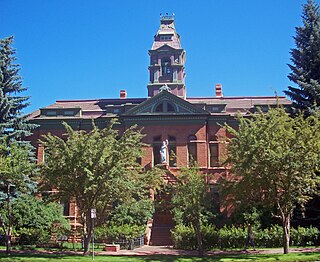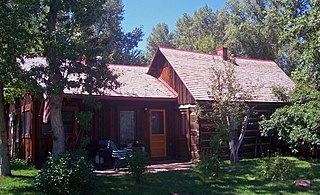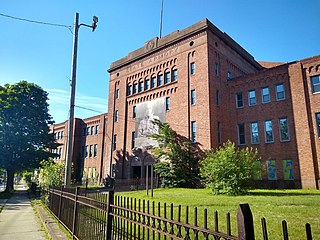
The City of Aspen is the Home Rule Municipality that is the county seat and the most populous municipality of Pitkin County, Colorado, United States. Its population was 6,658 at the 2010 United States Census. It is in a remote area of the Rocky Mountains' Sawatch Range and Elk Mountains, along the Roaring Fork River at an elevation just below 8,000 feet (2,400 m) above sea level on the Western Slope, 11 miles (18 km) west of the Continental Divide.

The Franklin Block is a historic commercial building in Brockton, Massachusetts. The three story brick Romanesque Revival-style building was built in 1888. Its construction marked the high point in the economic recovery of the city's Campello neighborhood, which had been devastated by fire in 1853, and is one of two 19th-century buildings in the area. The building was listed on the National Register of Historic Places in 1989.

The Hoosick Falls Armory is located along Church Street in the village by that name in New York, United States. It is a red brick building with castellated tower dating to the late 19th century.

City Market is a historic building located in downtown Davenport, Iowa, United States. It was individually listed on the National Register of Historic Places in 1984. In 2020 it was included as a contributing property in the Davenport Downtown Commercial Historic District.

The former Harmanus Bleecker Library is located at the intersection of Washington Avenue and Dove Street in Albany, New York, United States. It is a brick and stone Classical Revival building constructed in the 1920s. In 1996 it was listed on the National Register of Historic Places.

The New Scotland Avenue Armory is located on New Scotland Avenue in Albany, New York, United States. It is a large brick building constructed in the early 20th century. In 1994 it was listed on the National Register of Historic Places, one of two armories in the city of Albany to be so designated.

The Community Building, also known as Community Hall, Boll's Store, or Boll's Community Center, is a building in Princeton, Iowa, United States. It was listed on the National Register of Historic Places in 2008.

The La Fave Block is located at the intersection of East Cooper Avenue and South Hunter Street in Aspen, Colorado, United States. It is a brick commercial building erected in the late 1880s, during the initial mining boom that created Aspen. Today it is the second oldest brick commercial building in the city, and, along with its neighbors on East Cooper, the only structure left built by Frank LaFave, one of Aspen's early settlers. It was listed on the National Register of Historic Places in 1987.

The Wheeler Opera House is located at the corner of East Hyman Avenue and South Mill Street in Aspen, Colorado, United States. It is a stone building erected during the 1890s, from a design by Willoughby J. Edbrooke that blends elements of the Romanesque Revival and Italianate architectural styles. In 1972 it became the first property in the city to be listed on the National Register of Historic Places, and the second in Pitkin County. The upstairs auditorium hosts a number of events every year, ranging from nationally prominent music and comedy acts and some of the Aspen Music Festival's events to productions by local community groups.

The Hyman–Brand Building, often referred to as just the Brand Building, is located at the corner of South Galena Street and East Hopkins Avenue in Aspen, Colorado, United States. It is a two-story stone building erected in the late 19th century. At different stages in the city's history, it was owned by an entrepreneur who used the building in a way that redefined the city for that time. In 1985, it was listed on the National Register of Historic Places.

The Collins Block is a historic commercial building located at 204 South Mill Street in Aspen, Colorado. It is a brick and stone structure erected in the early 1890s.

The Pitkin County Courthouse is located on East Main Street in Aspen, Colorado, United States. It is a large brick building erected in the late 19th century that serves as offices not just of Pitkin County's courts but its other governmental agencies, and the Aspen police. A landmark of the city, it was listed on the National Register of Historic Places in 1975.

The Red Onion is a restaurant located on East Cooper Avenue in Aspen, Colorado, United States. It is the oldest restaurant in the city, housed in a three-story red brick Italianate building dating to the late 19th century. In 1987 it was listed on the National Register of Historic Places as "New Brick–The Brick Saloon", along with other historic properties in the city.

The former Riede's City Bakery building is located on East Hyman Street in Aspen, Colorado, United States. It is a small wooden commercial building erected in the 1880s. In 1987, it was listed on the National Register of Historic Places.

Aspen Community Church is located at the intersection of East Bleeker and North Aspen streets in Aspen, Colorado, United States. It is a stone building erected in the late 19th century. In 1975 it was listed on the National Register of Historic Places, the only house of worship in Pitkin County to be accorded that distinction.

The Wheeler–Stallard House is located on West Bleeker Street in Aspen, Colorado, United States. It is an 1880s brick structure built in the Queen Anne architectural style, and renovated twice in the 20th century. In 1975 it was listed on the National Register of Historic Places.

The Bowles–Cooley House is located at the corner of West Francis and North First streets in Aspen, Colorado, United States. It is a brick structure in the Queen Anne architectural style built during the 1880s. In 1987 it was listed on the National Register of Historic Places along with many other historic properties in the city.

The Matthew Callahan Log Cabin is located on South Third Street in Aspen, Colorado, United States. It was built in the early 1880s. In 1987 it was listed on the National Register of Historic Places along with a group of other historic properties in the city.

The Hotel Jerome is located on East Main Street in Aspen, Colorado, United States. It is a brick structure built in the 1880s that is often described as one of the city's major landmarks, its "crown jewel". In 1986 it was listed on the National Register of Historic Places. It is operated by Auberge Resorts.

The New Haven Armory is a historic building at 270–290 Goffe Street in the Dixwell neighborhood of New Haven, Connecticut, United States. Developed between 1928 and 1930, the armory served the Connecticut National Guard and the Second Company Governor's Foot Guard. It has also served as a venue for concerts, events and other civic functions in the community.





















